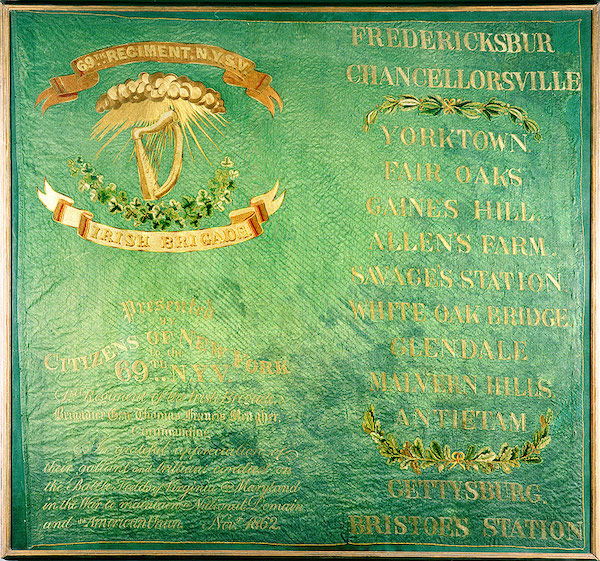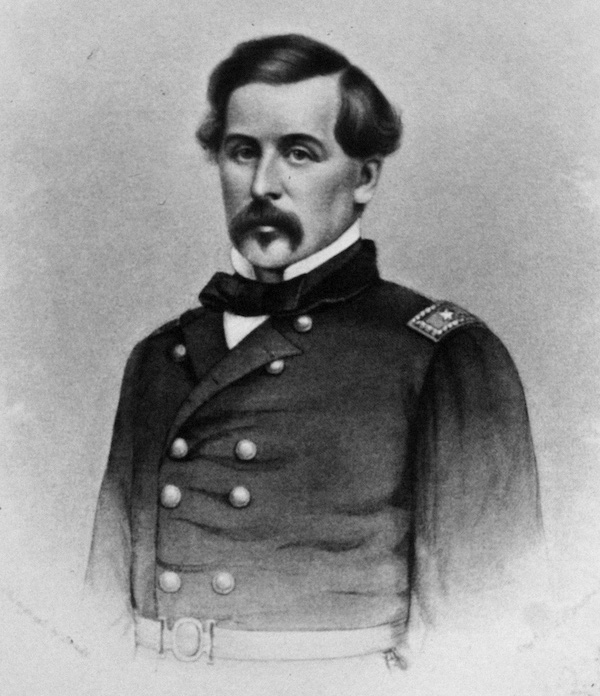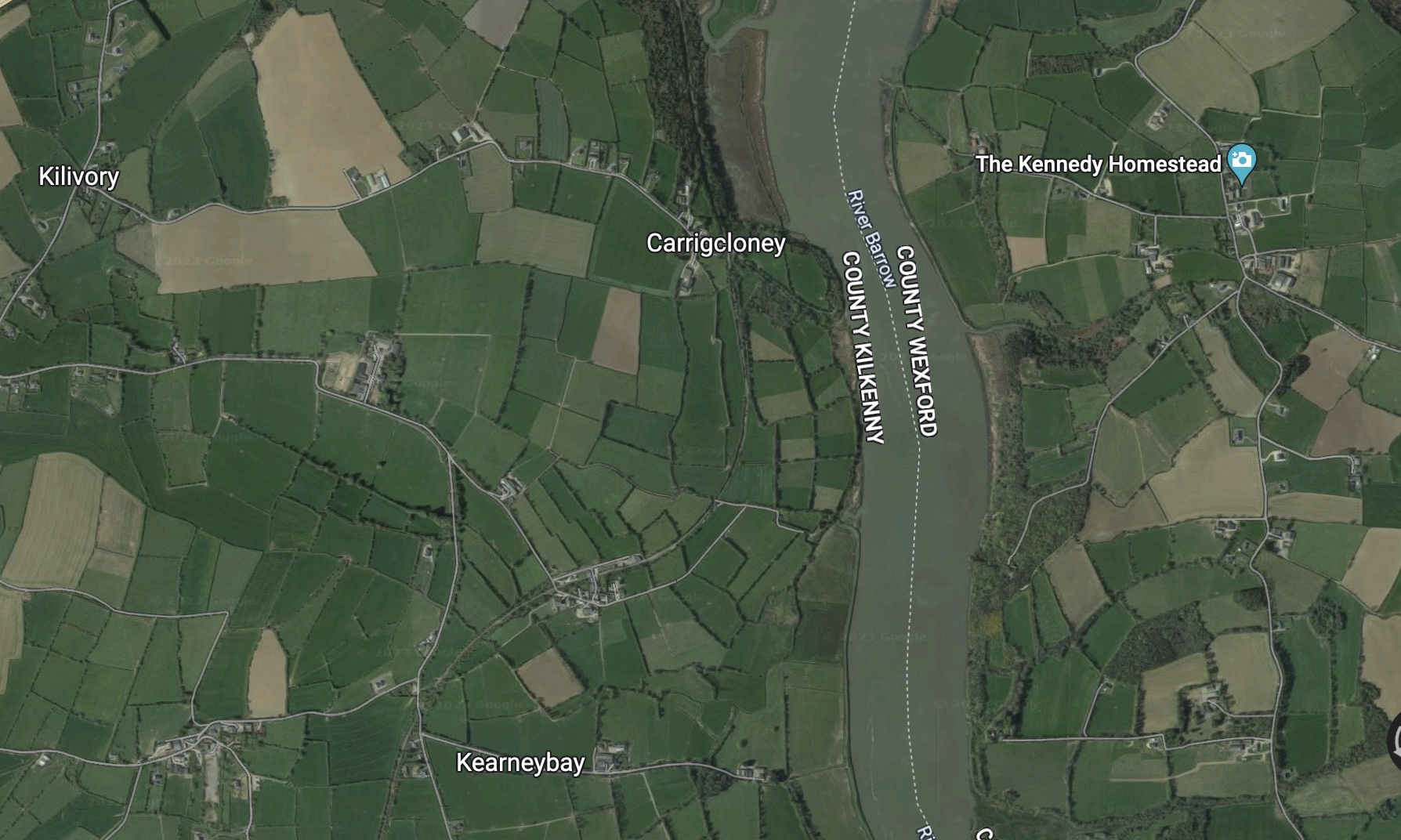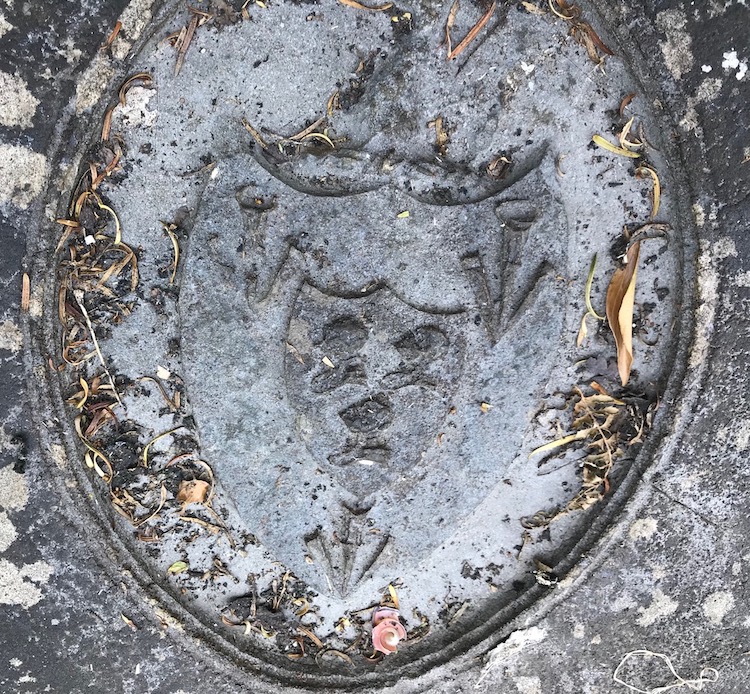0
-
An empty cart
You have no item in your shopping cart

Forstall or Forrestal History
On June 28th, 1963 President John Fitzgerald Kennedy addressed the Dáil Éireann in Ireland and in doing so he presented the assembly with an incredibly historic and symbolic gift, the flag of the 69th Infantry regiment, the 1st regiment of the Irish Brigade. Quoting president Kennedy directly from his speech we can feel the significance of this object and it’s binding connection with Ireland and United States:
“The 13th day of September, 1862, will be a day long remembered in American history. At Fredericksburg, Maryland, thousands of men fought and died on one of the bloodiest battlefields of the American Civil War. One of the most brilliant stories of that day was written by a band of 1,200 men who went into battle wearing a green sprig in their hats. They bore a proud heritage and a special courage, given to those who had long fought for the cause of freedom. I am referring, of course, to the Irish Brigade. General Robert E. Lee, the great military leader of the Southern Confederate forces, said of this group of men after the battle: “The gallant stand which this bold brigade made on the heights of Fredericksburg is well known. Never were men so brave. They ennobled their race by their splendid gallantry on that desperate occasion. Their brilliant, though hopeless, assaults on our lines excited the hearty applause of our officers and soldiers.”
“Of the 1,200 men who took part in that assault, 280 survived the battle. The Irish Brigade was led into battle on that occasion by Brigadier General Thomas F. Meagher, who had participated in the unsuccessful Irish uprising of 1848, was captured by the British and sent in a prison ship to Australia, from whence he finally came to America. In the fall of 1862, after serving with distinction and gallantry in some of the toughest fighting of this most bloody struggle, the Irish Brigade was presented with a new set of flags. In the city ceremony, the city chamberlain gave them the motto “The Union, our Country, and Ireland Forever.” Their old ones having been torn to shreds by bullets in previous battles, Captain Richard McGee took possession of these flags on September 2nd in New York City and arrived with them at the Battle of Fredericksburg and carried them in the battle. Today, in recognition of what these gallant Irishmen and what millions of other Irish have done for my country, and through the generosity of the Fighting 69th, I would like to present one of these flags to the people of Ireland.”

The Irish Brigade Flag of the 69th Regiment, presented to the Dáil Éireann by President John Fitzgerald Kennedy on June 28th, 1963
While there is indeed so much history that can be gleaned from this subject, our focus at this particular time will be on establishing connections which existed between the Forstall or Forrestal and Kennedy families. Through this road of inquiry we can gain a deeper insight into the familial connections that existed amongst the Forstall family.
A person of immense historical significance mentioned in John F. Kennedy’s speech, is of course, Thomas Francis Meagher, the commander of “The Fighting 69th” who was also known by his nickname “Meagher of the Sword.” Thomas Francis Meagher and William Smith O’Brien were the first to present the concept of the tricolour flag that is still used today by the Republic of Ireland. Meagher’s contributions to Ireland and America are so significant that entire books have been written about his life and deeds.

Thomas Francis Meagher (1823-1867), the Commander of the 69th Regiment of the Irish Brigade and direct lineal descendant of the Forstalls of Mullennahone and Carrickcloney Castles, Co. Kilkenny and the O’Kennedy Donn Chiefs of Upper Ormond, Co. Tipperary.
Thomas Francis Meagher was a 6th generation direct descendent of Edmond Dubh Forstall of Mullennahone, Gurteens, and Kellymount, a military leader that commanded the Irish at Limerick in 1690-1691. Through Meagher’s Grandmother, Christina Forstall or Forrestal, we are able to establish this descent and lineage. Christina Forstall or Forrestal married Thomas Quan, their daughter was Alicia Quan, the mother of Thomas Francis Meagher. Alicia Quan married Thomas Meagher, Sr., a successful merchant and ship owner.
The parents of Christina Forstall (Thomas Francis Meagher’s great-grandparents), were Edmond Bán Forstall who resided at Ringville, Co. Kilkenny and Alice Kennedy, the daughter of John Kennedy, Esq, of Morristown, Co Kildare. Edmond Bán Forstall was the son and heir of Pierce Forstall, Esq, of New Ross, a former captain of the Hibernia regiment who settled in New Ross after his father Edmond Dubh Forstall died; Pierce receiving his father’s inheritance as his eldest son and heir. Pierce Forstall of New Ross married Juliet Keating of Shanballyduffe, Co. TIpperary, who was the mother of his only son and heir Edmond Bán Forstall.
The marriage alliance between the Kennedy and Forstall or Forrestal family contained in Thomas Francis Meagher’s pedigree, is indeed an interesting one, especially when considering the fact that the Forstall or Forrestal lands of Carrickcloney were located directly across the River Barrow, from Dunganstown, where the ancestor of President John Fitzgerald Kennedy, Patrick Kennedy, was raised before emigrating to the United States. It is intriguing when we investigate the history of Dunganstown and learn that the lands of Dunganstown, in 1641, were in the possession of Arthur Keating, Esq, who like his neighbors, the Forstalls or Forrestals, was indicted for his involvement in the 1641 rebellion. Another aspect of interest is that after the Forrestal lands of Carrickcloney were confiscated Stephen Devereux was named as ‘titulado’ of the townland and that the Wexford Keating and Wexford Devereaux families formed alliances through marriage for generations,

The picture shows the proximity of the ancestral lands of the Forstall family of Carrigcloney or Carrickcloney, in relation to the Kennedy Homestead at Dunganstown; the two townlands located across the River Barrow from one another. Also shown on the map is Kilivory or Kilmakevoge, which contains a small church and burial ground where members of the Mullennahaone and Carrickcloney Forstall or Forrestal family are buried. This burial ground exhibits an 18th century vault or tomb where Edmond Bán Forstall (great-grandson of Pierce Forstall of Carrickcloney Castle) and his wife Alicia Kennedy are buried. The vault is encrusted with the arms of the Kennedy family, placed inside the arms of the Forstall family. Forrestalstown is located just north of Carrickcloney.
The aforementioned Arthur Keating, was of the Kilcowan or Kilcoan branch of the Keating family. Arthur was the son of Oliver Keating of Kilcowan Castle and Joan Butler, daughter of Piers Butler of Kayer Castle (which is now called Wilton Castle, near Enniscorthy, Co. Wexford). Arthur is mentioned as holding the lands of Dunganstown and BallyKelly in inquisitions during the period of the 1641 rebellion, when these lands were thereafter confiscated for his participation. Arthur Keating was wed to Ellen Devereux, the granddaughter of Nicholas Devereux and Eleanor Keating whose father James Keating served as Prior of Kilmainham of the Knights of St. John of Jerusalem in Ireland. The aforementioned, Edmond Dubh Forstall was the son and heir of Pierce Forstall or Forrestal of Carrickcloney Castle, and grandson of Edmond Forstall of Mullennahone Castle and Elizabeth Butler of Danganspidogue Castle; Elizabeth being a direct lineal descendant of Thomas Butler, who also served as Prior of Kilmainham and Grand Master or Head of the Knights of St. John of Jerusalem in Ireland. The Forstall or Forrestal family held their tradition as being descended from the Knights of St. John of Jerusalem, into the mid-nineteenth century.
John Kennedy of Morristown, Esq, was a direct descendant of the O’Kennedy Donn lineage, Gaelic Chiefs of Upper Ormond, Co. Tipperary. John was wed to Christian or Christina Lattin, the sister of George Lattin, and daughter of Patrick Lattin of Morristown-Lattin, Co. Kildare. As aforesaid, Alicia or Alice Kennedy, daughter of John Kennedy and Christina Lattin, married Edmond Bán Forstall of Ringville, grandson of Edmond Dubh Forstall, and son of Pierce Forstall of New Ross, Gent, who married Juliet or Julian Keating, of Shanballyduffe, Co. Tipperary. The previously mentioned, Thomas Butler, Prior of Kilmainham, in addition to being ancestor of the Butler lineage of Danganspidogue, was also ancestor of the Butler lineage who held Annaghs Castle located along the River Barrow just north of Forrestalstown, and the Butler lineage of Shanballyduffe, Co. TIpperary, where Julian Keating hailed from. Thus, the Keating, Butler, and Forstall or Forrestal families, who were settled along the River Barrow, were intimately affiliated with The Order of the Knights of St. John of Jerusalem or Knights Hospitaller.

The Forstall coat of arms with the arms of the Kennedy family, placed inside of them, which is engraved on the top of the Forrestal vault at Kilmakevoge or Kilivory cemetary, in Glenmore parish, Co. Kilkenny and dates from the late 18th century. The remains in the vault are the chief line of the Mullennahone and Carrickcloney Forstalls.
The local tradition told to the present author by Martin Forristal of Rochestown, Co. Kilkenny, whose family are still in possession of Forristal lands at Rochestown in the Barony of Ida, was that the Kennedy family of Dunganstown (John F. Kennedy’s ancestral lineage) came from the Barony of Ida, Co. Kilkenny, and crossed the River Barrow and settled at Dunganstown, a townland which, as shown above, is located directly across the River Barrow from the Forstall castle residence and lands of Carrickcloney which were held by Pierce Forstall of Carrickcloney (d. 1683), great-grandfather of Edmond Bán Forstall of Ringville.
In the 1659 census for the Barony of Shelburne, Co. Wexford, where Dunganstown is located, there are no Kennedy families shown living in this region of Wexford. Which perhaps signifies that the Kennedy’s migrated to Dunganstown, Co. Wexford, between the period of 1660-1775.
Of interest, is the fact that a person who was in possession of a share of the lands of Dunganstown and Ballykelly in 1777 (as is shown in RD Memorial Deed 214885) was Thomas Houghton, Esq, of Kilmannock, Co. Wexford, who shared an intimate relationship with Edmond Bán Forstall of Ringville and Alice Kennedy. Houghton served as godparent to Edmond Bán and Alice’s daughter Ally Forrestal in 1772 and was the husband of Margaret Wyse whose sister Anne Wyse was wed to John McCarthy of Springhouse, Tipperary (a lineal descendant of the McCarthy-Reagh Dynasty). John McCarthy’s nephew John Ryan (the son of Elizabeth McCarthy and Daniel Ryan) was wed to Mary Kennedy, the sister of Alicia Kennedy (wife of Edmond Bán Forstall). Thomas Hougton’s sister Mary (or Jane), was wife to James Rossiter of Rosemount, New Ross, whom Patrick Devereux of New Ross lived alongside, at Rosemount.
In 1662, an Edmond Kennedy is shown as paying a hearth tax at Aylwardstown, which adjoins the townland of Carrickcloney. Aylwardstown, was formerly the residence and property of Nicholas Aylward, whose daughter Mary was wed to Pierce Forstall of Carrickcloney Castle, great-grandfather of Edmond Bán Forstall of Ringville (who was wed to Alicia Kennedy). Furthermore, Edmond Forstall of Mullennahone of Castle, the great-great-grandfather of Edmond Bán Forstall, and father of Pierce Forstall of Carrickcloney Castle, had held the townland of Parkestown, near Mullennahone, before it was forfeit in 1653, and a William Kennedy is shown paying a Hearth Tax there in 1662. Also, in 1662, John Kennedy is shown as paying a hearth tax at Gallstown, which were lands the Gall-Burke family held; this family intermarrying with FitzGerald-Dea lineage who then intermarried with the Aylward family of Aylwardstown. The aforementioned Edmond Forstall of Mullennahone Castle was the grandson of Richard Forstall of Mullennahone Castle.
17th century records show both the Kennedy and Forstall families linked to the Butlers of Ormond including an important marriage alliance which occurred between the Butlers and the O’Kennedy Donn lineage, who held the castle and lands of Ballinaclogh, Co. Tipperary, directly from the Butlers of Ormond. Notably, there were members of the O’Kennedy Donn lineage, of Upper Ormond, Co. Tipperary, using the first names Edmond, William, and John in the early 17th century.
Phillip mac Dermot O’Kennedy of Ballinaclogh, son of Dermot O’Kennedy, became the O’Kennedy Donn, Chief of the Upper Ormond O’Kennedy Dynasty in 1583, which occurred after the death Conor mac Teige; the former chief who was brother to John O’Kennedy of Ballinaclogh. John Kennedy of Morristown (the father of Alicia Kennedy who married Edmond Forstall of Ringville) was directly descended from said Dermot O’Kennedy whose son Hugh mac Dermot Kennedy, was brother to the aforementioned chief, Phillip mac Dermot O’Kennedy.
Hugh mac Dermot Kennedy’s son Brian was ancestor to John Kennedy of Morristown; while another son Rory was wed to Joan Butler, a member of the Ormond Butler Dynasty. William Kennedy, another son of Hugh mac Dermot, and brother to Rory and Brian, was father to Dermot and Donough Kennedy. An important record from 1598 regarding Hugh mac Dermot Kennedy, ancestor of John Kennedy of Morristown, and brother to William and Rory, shows that Richard Forstall who held the position as Sovereign of the Borough Callan, seized Hugh mac Dermot’s lands of Ballinaclogh, and in 1601 said Hugh mac Dermot Kennedy, Richard Forstall, and William Troddy, then sold Hugh’s lands of Ballinaclogh jointly (see pages 132-133 from the piece titled The decline of the O’Kennedy’s of Ormond by Matthew Boland in the Tipperary Historical Journal published in 1994).
Thus, we have a clear late sixteenth century and early seventeenth century connection between the Kennedy and Forstall families involving the direct lineal ancestor of Alicia Kennedy whose husband Edmond Bán Forstall of Ringville was the direct male line descendant of Pierce Forstall of Carrickcloney Castle and Richard Forstall who held Mullennahone Castle. It is of interest then if Hugh mac Dermot O’Kennedy’s dealings with Richard Forstall, Sovereign of Callan, later involved Forstall or Aylward lands in the Barony of Ida where members of the Kennedy family were settled by 1662.
An additional connection existed with the Forstalls and Aylwards in the Borough of Callan, through the Candler family, who resided at Callan Castle in the early 18th century. Rev. Henry Candler, of this family, was wed to Susanna Matthews, the widow Edmond Waring of Kellymount, grandson of the aforementioned Edmond Dubh Forstall, by his mother Mary Forstall. Edmond Dubh Forstall’s grandson, Edmond Bán Forstall (first cousin to Edmond Waring), being wed to Hugh mac Dermot Kennedy’s descendent Alicia Kennedy. Susanna Matthews who married Dr. Henry Candler, had also been previously married to Nicholas Aylward of Shankill, the great-grandson of Nicholas Aylward who held Aylwardstown where Edmond Kennedy paid a hearth tax in 1662. Part of Aylwardstown akin to Carrickcloney, was located directly across the River Barrow from Dunganstown, Co. Wexford (this part of Aylwardstown was later renamed ‘Kearney’s Bay’). Nicholas Aylward’s daughter Mary Aylward, as aforementioned was the wife of Pierce Forstall of Carrickcloney Castle and mother to Edmond Dubh Forstall.
As mentioned on this website on the page titled ‘Castle Forstall,’ in William Hole’s 1607 map of Ireland, there are only three castles shown in Co. Kilkenny, despite the existence of several castle settlements which could have been depicted. Significantly, in addition to Kilkenny Castle, held by the Butlers of Ormond, the two remaining castles that are depicted are Callan Castle, where Richard Forstall held the position as Sovereign in 1593; and ‘Ca Testal,‘ which appears to have been Mullennahone Castle, which was held by Richard Forstall, grandfather of Edmond Forstall of Mullennahone.
It is apparent that the Forstalls, who intermarried with the Butler lineage of Danganspidoge (distant cousins to the Ormond Butlers) were one of, if not the most influential family who held lands in the Barony of Ida, Co. Kilkenny, during the 17th century; making it improbable that William Kennedy of Parkestown (this townland being formerly held by Richard Forstall of Mullennahone Castle and then afterwards Richard’s grandson Edmond Forstall) and Edmond Kennedy of Aylwardstown, would not be linked or influenced by the activities of the Forstall family.
In light of the information above, a probable key then to understanding the ancestral Kennedy lineage of the Kennedy Dynasty which came from Dunganstown, Co. Wexford, and emigrated to the United States, may therefore be ensconced in the aforementioned connections which existed between the Forstall, Kennedy, Butler and Aylward families; and particularly the O’Kennedy Donn lineage which held Ballinaclogh Castle and lands in Co. Tippeary. This lineage being the ancestral lineage of John Kennedy whose daughter Alicia married Edmond Forstall of Ringville (see Dermot F. Gleeson’s 1943 Article in the North Munster Antiquarian Journal titled “The Manor of Ballinclogh in Ormond” for further information concerning the O’Kennedy Donn lineage).
Furthermore, additional significant connections existed amongst the Forrestals and the Kennedy family of Dunganstown, which can be demonstrated beginning with John Williams of New Ross, the ship captain of the famed Dunbrody; the vessel which arrived in Boston from New Ross with Patrick Kennedy of Dunganstown, ancestor of the Kennedy Dynasty, onboard.
Captain John Williams was father of William George Williams who was wed to Ellen Forrestal, the daughter of William Forrestal and Elizabeth Joyce. This William Forrestal, father of Ellen Forrestal, was a New Ross merchant and was the son of William Forrestal and Eleanor Shallow. In 1798, William Forrestal, husband of Eleanor Shallow (William and Eleanor being the grandparents of Ellen Forrestal), had served as godparent to Mary Forrestal, the daughter of Terence Brien, Gent, of Rosemount, New Ross, and Mary Forrestal. Previously, In 1791, this Terence Brien had served as a witness to a deed regarding lands at Ballyanne, Co. Wexford, involving Henry Houghton (brother of the aforementioned Thomas Houghton, who held a share of Dunganstown and Ballykelly in 1777, and whose sister married James Rossiter of Rosemont), and Patrick Devereux of Rosemount, New Ross, husband of Joanna Forrestal.
Subsequent to Patrick Devereux’s death in 1803 his leasehold was placed in the trust of Michael Forrestal of Whitechurch, Co. Wexford (undoubtedly a relation to Patrick’s wife Joanna Forrestal), for his only son Henry Devereux. The townland of Whitechurch, Co. Wexford, where Michael Forrestal lived, is the townland where the Kennedy’s of Dunganstown are buried and is located directly across the River Barrow from Rochestown and Ringville which Edmond Bán Forstall held by title deed.
Furthermore, in 1788 Edmond Bán Forstall of Ringville, husband of Alicia Kennedy, sold his residence at Ringville to Nicholas Devereux, a wine merchant of Cadiz; and in 1796 said Nicholas Devereux served as godparent to James Sutton and Margaret Forrestal’s son James, baptized at Ringville. Previously, in 1788 Peter Crane, maltster of New Ross, had served as godparent to James Sutton and Margaret Forrestal’s daughter Bridget Sutton baptized at Rochestown. In unifying accord, In 1795, Peter Crane also served as godparent to Terence Brien and Mary Forrestal’s son Michael Brien with Joanna Forrestal, the wife of Patrick Devereux of Rosemount. Then, in 1806, the marriage of Patrick Kennedy of Whitechurch, Co. Wexford, to Mary Forrestal of New Ross occurred, with John Kennedy and Richard Forrestal serving as witnesses to the marriage; directly connecting the Kennedys residing in the parish of Whitechurch (where Dunganstown is located) to the New Ross Forrestals’ through intermarriage.
Other aspects of Forrestal Kennedy connections that can be examined have their roots in US politics and concern James Vincent Forrestal who became the 1st United States Secretary of Defense and also his son Michael Forrestal. James Vincent Forrestal was the son of a man named James Forrestal, this James Forrestal who emigrated to America had a stepfather named Patrick Kennedy. Of course this is a coincidental connection, but interesting nonetheless.
James Vincent Forrestal, was said to be a friend of John Fitzgerald Kennedy’s father, Joseph P. Kennedy, and in 1945, James Vincent Forrestal accompanied the 28 year old, John F. Kennedy, to a war torn Germany. The history concerning James Vincent Forrestal is vast, but the origins of his Forrestal branch are still uncertain. It is possible that he may have been a descendant of the Forrestalstown branch, who lived in the townland just north of Carrickcloney and had members who were transplanted to Connacht due to their participation in the 1641 rebellion.

President John Fitzgerald Kennedy visits the Grave of James Vincent Forrestal, the 1st United States Secretary of Defense, at Arlington National Cemetery, Arlington, Va.
Michael Forrestal, the son of James Vincent Forrestal, served under President Kennedy as a senior member of staff of the National Security Council, he was one of the key aids to the National Security Advisor to President Kennedy, McGeorge Bundy. Michael Forrestal had a brother called Peter Ogden Forrestal who worked for Bankers Trust in London and had a home in Ireland, he died at the age of 52.
Copyright © 2023-2024 Michael Forrestal Keller